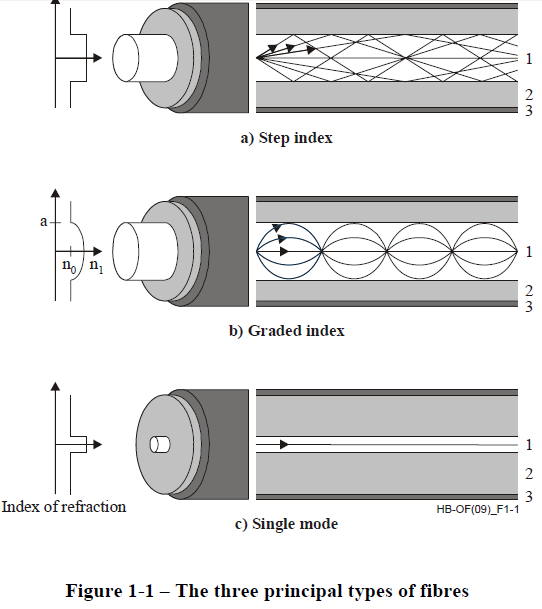Optical Fibres Characterstics
Optical Fibres characterstics:
Single-mode and multimode optical fibres:
Multimode optical fibres are dielectric waveguides which can have many propagation modes. Light in these modes follows paths that can be represented by rays as shown in Figure 1-1a and 1-1b, where regions 1, 2 and 3 are the core, cladding and coating, respectively. The cladding glass has a refractive index, a parameter related to the dielectric constant, which is slightly lower than the refractive index of the core glass.

The fibre in Figure 1-1a is called “step index” because the refractive index changes abruptly from cladding to core. As a result, all rays within a certain angle will be totally reflected at the core-cladding boundary. Rays striking the boundary at angles greater than this critical angle will be partially reflected and partially
transmitted out through the boundary towards the cladding and coating. After many such reflections, the energy in these rays will eventually be lost from the fibre. Region 3, the coating, is a plastic which protects the glass from abrasion.
The paths along which the rays (modes) of this step-index fibre travel differ depending on their angle relative to the axis. As a result, the different modes in a pulse arrive at the far end of the fibre at different times, resulting in pulse spreading, which limits the bit rate of a digital signal that can be transmitted.
The different mode velocities can be nearly equalized by using a “graded-index” fibre as shown in Figure 1-1b. Here the refractive index changes smoothly from the centre out in a way that causes the end-toend travel time of the different rays to be nearly equal, even though they traverse different paths. This velocity equalization can reduce pulse spreading by a factor of 100 or more. By reducing the core diameter and the refractive index difference between the core and the cladding only one mode (the fundamental one) will propagate and the fibre is then “single-mode” (Figure 1-1c). In this case there is no pulse spreading at all
due to the different propagation time of the various modes. The cladding diameter is 125 μm for all the telecommunication types of fibres. The core diameter of the multimode fibres is 50 μm, whereas that of the single-mode fibres is 8 to 10 μm.